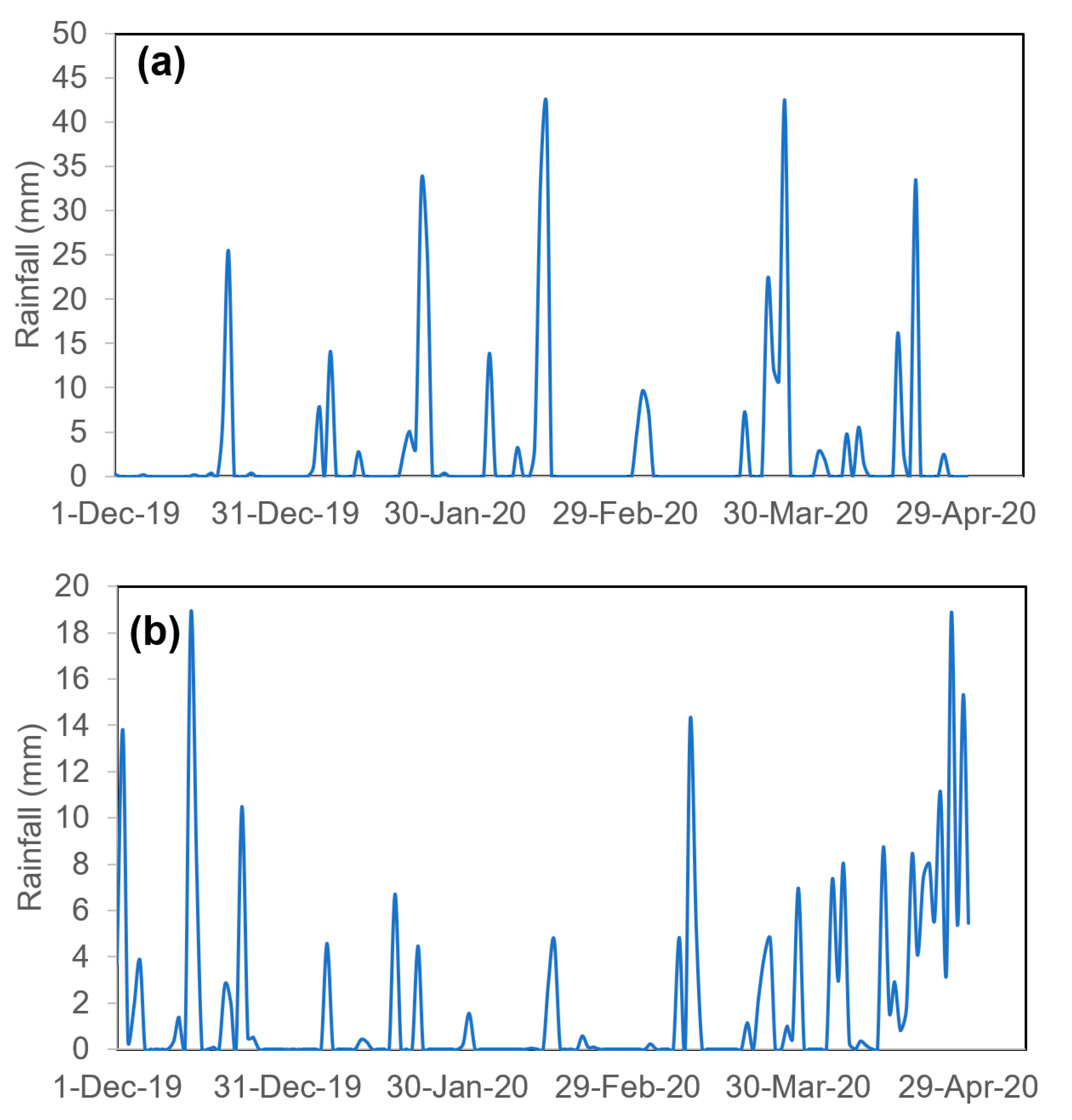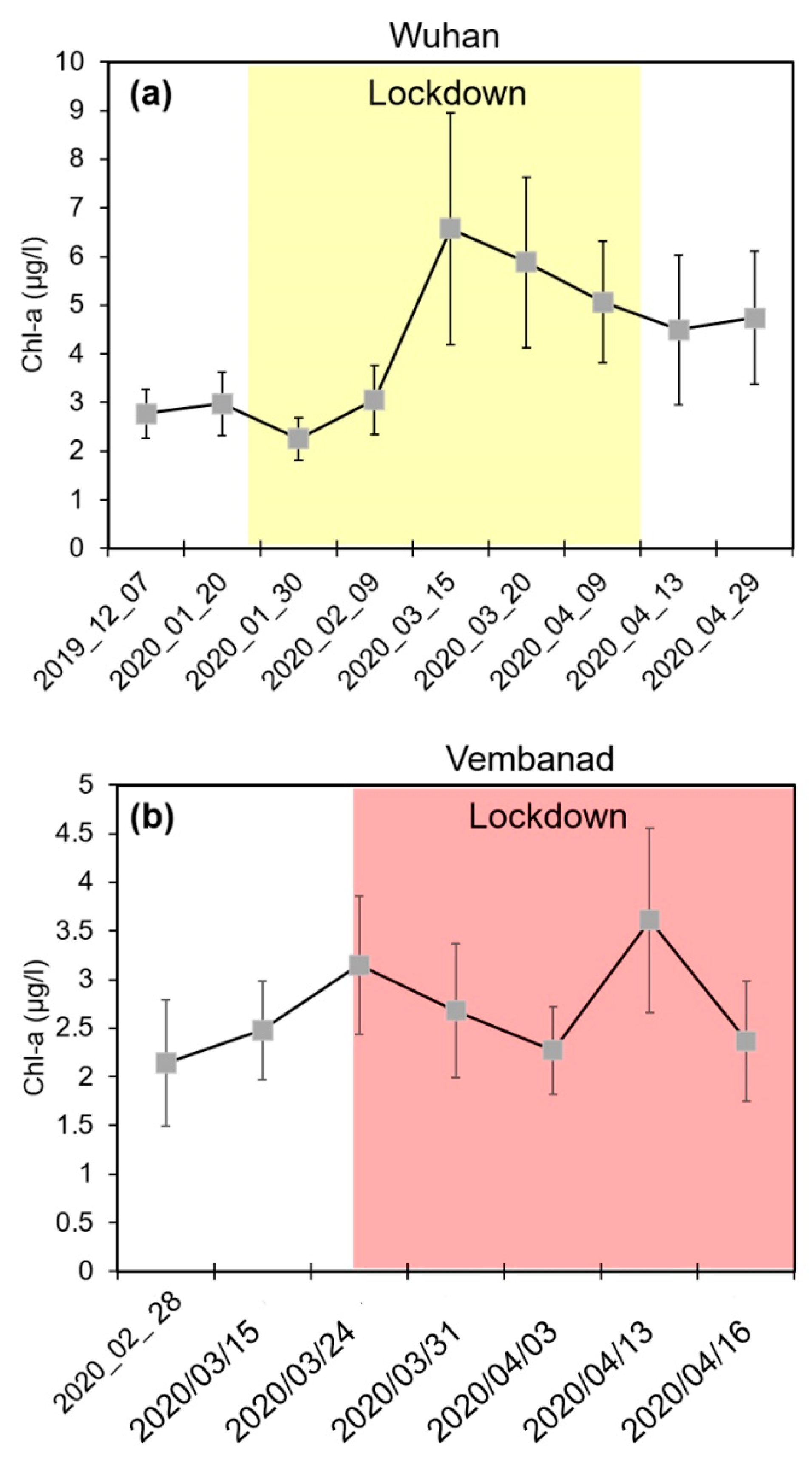Did the COVID-19 Lockdown-Induced Hydrological Residence Time Intensify the Primary Productivity in Lakes? Observational Results Based on Satellite Remote Sensing
Abstract
1. Introduction
2. Study Area
3. Data and Methodology
3.1. Theoretical Framework
3.2. Image Acquisition and Data Processing
3.3. Chlorophyll-a Retrieval
4. Results and Discussion
4.1. Lakes in Wuhan
4.2. Vembanad Lake, India
4.3. Validation
5. Discussion and Concluding Remarks
Supplementary Materials
Author Contributions
Funding
Acknowledgments
Conflicts of Interest
References
- Leray, S.; Engdahl, N.B.; Massoudieh, A.; Bresciani, E.; McCallum, J. Residence time distributions for hydrologic systems: Mechanistic foundations and steady-state analytical solutions. J. Hydrol. 2016, 543, 67–87. [Google Scholar] [CrossRef]
- Baker, M.A.; Dahm, C.N.; Valett, H.M. Anoxia, anaerobic metabolism biogeochemistry of the stream water-ground water interface. In Streams and Ground Waters; Academic Press: San Diego, CA, USA, 2000; pp. 259–284. [Google Scholar]
- Neumann, R.B.; LaBolle, E.M.; Harvey, C.F. The Effects of Dual-Domain Mass Transfer on the Tritium-Helium-3 Dating Method. Environ. Sci. Technol. 2008, 42, 4837–4843. [Google Scholar] [CrossRef]
- Zwart, J.A.; Sebestyen, S.D.; Solomon, C.T.; Jones, S.E. The influence of hydrologic residence time on lake carbon cycling dynamics following extreme precipitation events. Ecosystems 2017, 20, 1000–1014. [Google Scholar] [CrossRef]
- Hein, T.; Baranyi, C.; Heiler, G.; Holarek, C.; Riedler, P.; Schiemer, F. Hydrology as a major factor determining plankton development in two floodplain segments and the River Danube, Austria. Large Rivers 1999, 11, 439–452. [Google Scholar] [CrossRef]
- León, J.G.; Beamud, S.G.; Temporetti, P.F.; Atencio, A.G.; Diaz, M.M.; Pedrozo, F.L. Stratification and residence time as factors controlling the seasonal variation and the vertical distribution of chlorophyll-a in a subtropical irrigation reservoir. Int. Rev. Hydrobiol. 2016, 101, 36–47. [Google Scholar] [CrossRef]
- Stumpner, E.B.; Bergamaschi, B.A.; Kraus, T.E.; Parker, A.E.; Wilkerson, F.P.; Downing, B.D.; Dugdale, R.C.; Murrell, M.C.; Carpenter, K.D.; Orlando, J.L.; et al. Spatial variability of phytoplankton in a shallow tidal freshwater system reveals complex controls on abundance and community structure. Sci. Total Environ. 2020, 700, 134392. [Google Scholar] [CrossRef] [PubMed]
- Worldometers. Coronavirus Updates. Available online: https://www.worldometers.info/ (accessed on 3 May 2020).
- ESA COVID-19: Nitrogen Dioxide over China. Available online: https://www.esa.int/Applications/Observing_the_Earth/Copernicus/Sentinel-5P/COVID-19_nitrogen_dioxide_over_China (accessed on 17 April 2020).
- Yunus, A.P.; Masago, Y.; Hijioka, Y. COVID-19 and surface water quality: Improved lake water quality during the lockdown. Sci. Total Environ. 2020, 731, 139012. [Google Scholar] [CrossRef]
- O’Reilly, J.E.; Maritorena, S.; Mitchell, B.G.; Siegel, D.A.; Carder, K.L.; Garver, S.A.; Kahru, M.; McClain, C. Ocean color chlorophyll algorithms for SeaWiFS. J. Geophys. Res. Oceans 1998, 103, 24937–24953. [Google Scholar] [CrossRef]
- Nukapothula, S.; Chen, C.; Yunus, A.P.; Wu, J. Satellite-based observations of intense chlorophyll-a bloom in response of cold core eddy formation: A study in the Arabian Sea, Southwest Coast of India. Reg. Stud. Mar. Sci. 2018, 24, 303–310. [Google Scholar] [CrossRef]
- Gao, K.; Xu, J.; Gao, G.; Li, Y.; Hutchins, D.A.; Huang, B.; Wang, L.; Zheng, Y.; Jin, P.; Cai, X.; et al. Rising CO2 and increased light exposure synergistically reduce marine primary productivity. Nat. Clim. Change 2012, 2, 519–523. [Google Scholar] [CrossRef]
- Hu, C.; Lee, Z.; Franz, B. Chlorophyll a algorithms for oligotrophic oceans: A novel approach based on three-band reflectance difference. J. Geophys. Res. Oceans 2012, 117. [Google Scholar] [CrossRef]
- Scofield, A.E.; Watkins, J.M.; Osantowski, E.; Rudstam, L.G. Deep chlorophyll maxima across a trophic state gradient: A case study in the Laurentian Great Lakes. Limnol. Oceanogr. 2020. [Google Scholar] [CrossRef]
- Castelao, R.M.; Mavor, T.P.; Barth, J.A.; Breaker, L.C. Sea surface temperature fronts in the California Current System from geostationary satellite observations. J. Geophys. Res. Oceans 2006, 111. [Google Scholar] [CrossRef]
- Atique, U.; An, K.-G. Landscape heterogeneity impacts water chemistry, nutrient regime, organic matter and chlorophyll dynamics in agricultural reservoirs. Ecol. Indic. 2020, 110, 105813. [Google Scholar] [CrossRef]
- Sruthy, S.; Ramasamy, E. Microplastic pollution in Vembanad Lake, Kerala, India: The first report of microplastics in lake and estuarine sediments in India. Environ. Pollut. 2017, 222, 315–322. [Google Scholar] [CrossRef]
- Zhu, S.; Yang, G.; Dai, J. Sediment Management in East Lake, China: A Combined Bio-Physical and Socioeconomic Approach for Managing Sediments in a Polluted Lake System. Pol. J. Environ. Stud. 2018, 27, 1891–1900. [Google Scholar] [CrossRef]
- Dickman, M. Some Effects of Lake Renewal on Phytoplankton Productivity and Species Composition 1. Limnol. Oceanogr. 1969, 14, 660–666. [Google Scholar] [CrossRef]
- Gomes, L.; Miranda, L. Hydrologic and climatic regimes limit phytoplankton biomass in reservoirs of the Upper Paraná River Basin, Brazil. Hydrobiologia 2001, 457, 205–214. [Google Scholar] [CrossRef]
- Lee, S.; Lee, S.; Kim, S.H.; Park, H.; Park, S.; Yum, K. Examination of critical factors related to summer Chlorophyll a concentration in the Sueo Dam Reservoir, Republic of Korea. Environ. Eng. Sci. 2012, 29, 502–510. [Google Scholar] [CrossRef]
- Wan, Y.; Qiu, C.; Doering, P.; Ashton, M.; Sun, D.; Coley, T. Modeling residence time with a three-dimensional hydrodynamic model: Linkage with Chlorophyll a in a subtropical estuary. Ecol. Model. 2013, 268, 93–102. [Google Scholar] [CrossRef]
- Liu, W.-C.; Chen, W.-B.; Kuo, J.-T.; Wu, C. Numerical determination of residence time and age in a partially mixed estuary using three-dimensional hydrodynamic model. Cont. Shelf Res. 2008, 28, 1068–1088. [Google Scholar] [CrossRef]
- Vanhellemont, Q.; Ruddick, K. Atmospheric correction of metre-scale optical satellite data for inland and coastal water applications. Remote Sens. Environ. 2018, 216, 586–597. [Google Scholar] [CrossRef]
- Vanhellemont, Q. Adaptation of the dark spectrum fitting atmospheric correction for aquatic applications of the Landsat and Sentinel-2 archives. Remote Sens. Environ. 2019, 225, 175–192. [Google Scholar] [CrossRef]
- Caballero, I.; Stumpf, R.P. Retrieval of nearshore bathymetry from Sentinel-2A and 2B satellites in South Florida coastal waters. Estuar. Coast. Shelf Sci. 2019, 226, 106277. [Google Scholar] [CrossRef]
- Pahlevan, N.; Roger, J.-C.; Ahmad, Z. Revisiting short-wave-infrared (SWIR) bands for atmospheric correction in coastal waters. Opt. Exp. 2017, 25, 6015–6035. [Google Scholar] [CrossRef]
- Clark, D.K.; Baker, E.T.; Strong, A.E. Upwelled spectral radiance distribution in relation to particulate matter in sea water. Bound. Layer Meteorol. 1980, 18, 287–298. [Google Scholar] [CrossRef]
- Gordon, H.R.; Clark, D.K. Remote sensing optical properties of a stratified ocean: An improved interpretation. App. Opt. 1980, 19, 3428–3430. [Google Scholar] [CrossRef]
- McKee, D.; Cunningham, A.; Dudek, A. Optical water type discrimination and tuning remote sensing band-ratio algorithms: Application to retrieval of chlorophyll and Kd (490) in the Irish and Celtic Seas. Estuar. Coast. Shelf Sci. 2007, 73, 827–834. [Google Scholar] [CrossRef]
- Bowers, D.G.; Harker, G.E.L.; Stephan, B. Absorption spectra of inorganic particles in the Irish Sea and their relevance to remote sensing of chlorophyll. Int. J. Remote Sens. 1996, 17, 2449–2460. [Google Scholar] [CrossRef]
- O’Reilly, J.E.; Maritorena, S.; Siegel, D.A.; O’Brien, M.C.; Toole, D.; Mitchell, B.G.; Kahru, M.; Chavez, F.P.; Strutton, P.; Cota, G.F.; et al. Ocean color chlorophyll a algorithms for SeaWiFS, OC2, and OC4: Version 4. In SeaWiFS Postlaunch Calibration and Validation Analyses; NASA Center for AeroSpace Information: Hanover, MD, USA, 2000; Volume 3, pp. 9–23. [Google Scholar]
- Jena, B. The effect of phytoplankton pigment composition and packaging on the retrieval of chlorophyll-a concentration from satellite observations in the Southern Ocean. Int. J. Remote Sens. 2017, 38, 3763–3784. [Google Scholar] [CrossRef]
- Nagamani, P.; Hussain, M.; Choudhury, S.; Panda, C.; Sanghamitra, P.; Kar, R.; Das, A.; Ramana, I.; Rao, K. Validation of chlorophyll-a algorithms in the coastal waters of Bay of Bengal initial validation results from OCM-2. J. Ind. Soc. Remote Sens. 2013, 41, 117–125. [Google Scholar] [CrossRef]
- O’Reilly, J.E.; Werdell, P.J. Chlorophyll algorithms for ocean color sensors-OC4, OC5 & OC6. Remote Sens. Environ. 2019, 229, 32–47. [Google Scholar]
- Witter, D.L.; Ortiz, J.D.; Palm, S.; Heath, R.T.; Budd, J.W. Assessing the application of SeaWiFS ocean color algorithms to Lake Erie. J. Gt. Lakes Res. 2009, 35, 361–370. [Google Scholar] [CrossRef]
- Yunus, A.P.; Dou, J.; Sravanthi, N. Remote sensing of chlorophyll-a as a measure of red tide in Tokyo Bay using hotspot analysis. Remote Sens. Appl. Soc. Environ. 2015, 2, 11–25. [Google Scholar] [CrossRef]
- Pahlevan, N.; Smith, B.; Schalles, J.; Binding, C.; Cao, Z.; Ma, R.; Alikas, K.; Kangro, K.; Gurlin, D.; Hà, N.; et al. Seamless retrievals of chlorophyll-a from Sentinel-2 (MSI) and Sentinel-3 (OLCI) in inland and coastal waters: A machine-learning approach. Remote Sens. Environ. 2020, 240, 111604. [Google Scholar] [CrossRef]
- Winarso, G.; Marini, Y. MODIS standard (OC3) chlorophyll-a algorithm evaluation in Indonesian seas. Int. J. Remote Sens. Earth Sci. 2017, 11, 11–20. [Google Scholar] [CrossRef]
- Reynolds, C.S. The Ecology of Phytoplankton; Cambridge University Press: Cambridge, UK, 2006. [Google Scholar]
- May, C.L.; Koseff, J.R.; Lucas, L.V.; Cloern, J.E.; Schoellhamer, D.H. Effects of spatial and temporal variability of turbidity on phytoplankton blooms. Mar. Ecol. Prog. Ser. 2003, 254, 111–128. [Google Scholar] [CrossRef]
- Bennion, D.H.; Warner, D.M.; Esselman, P.C.; Hobson, B.; Kieft, B. A comparison of chlorophyll a values obtained from an autonomous underwater vehicle to satellite-based measures for Lake Michigan. J. Gt. Lakes Res. 2019, 45, 726–734. [Google Scholar] [CrossRef]






| S. No | Wuhan Lakes | Vembanad Lake |
|---|---|---|
| 1 | ID: LC08_L1TP_123039_20191207_20191217_01_T1 Acquisition Date: 2019-12-07, Path: 123 Row: 39 | ID: LC08_L1TP_144053_20200228_20200313_01_T1 Acquisition Date: 2020-02-28, Path: 144, Row: 53 |
| 2 | ID: L1C_T50RKU_A023910_20200120T030612 Acquisition Date: 2020/01/20, Tile Number: T50RKU | ID: LC08_L1TP_144053_20200315_20200325_01_T1 Acquisition Date: 2020-03-15 |
| 3 | ID: L1C_T50RKU_A024053_20200130T030534 Acquisition Date: 2020/01/30 | ID: LC08_L1TP_144053_20200331_20200410_01_T1 Acquisition Date: 2020-03-31 |
| 4 | ID: LC08_L1TP_123039_20200209_20200211_01_T1 Acquisition Date: 2020-02-09 | ID: L1C_T43PFL_A024755_20200319T051246 Acquisition Date: 2020/03/19, Tile Number: T43PFL |
| 5 | ID: L1C_T50RKU_A015788_20200315T030729 Acquisition Date: 2020/03/15 | ID: L1C_T43PFL_A015918_20200324T052110 Acquisition Date: 2020/03/24 |
| 6 | ID: L1C_T50RKU_A024768_20200320T030130 Acquisition Date: 2020/03/20 | D: LC08_L1TP_144053_20200331_20200410_01_T1 Acquisition Date: 2020-03-31 |
| 7 | ID: L1C_T50RKU_A025054_20200409T030244 Acquisition Date: 2020/04/09 | ID: L1C_T43PFL_A016061_20200403T052351 Acquisition Date: 2020/04/03 |
| 8 | ID: LC08_L1TP_123039_20200413_20200422_01_T1 Acquisition Date: 2020-04-13 | ID: LC08_L1TP_144053_20200416_20200423_01_T1 Acquisition Date: 2020-04-16 |
| 9 | ID: L1C_T50RKU_A025340_20200429T030455 Acquisition Date: 2020/04/29 | |
| 10 | ID: LC08_L1TP_123039_20200429_20200509_01_T1 Acquisition Date: 2020-04-29 |
© 2020 by the authors. Licensee MDPI, Basel, Switzerland. This article is an open access article distributed under the terms and conditions of the Creative Commons Attribution (CC BY) license (http://creativecommons.org/licenses/by/4.0/).
Share and Cite
Avtar, R.; Kumar, P.; Supe, H.; Jie, D.; Sahu, N.; Mishra, B.K.; Yunus, A.P. Did the COVID-19 Lockdown-Induced Hydrological Residence Time Intensify the Primary Productivity in Lakes? Observational Results Based on Satellite Remote Sensing. Water 2020, 12, 2573. https://doi.org/10.3390/w12092573
Avtar R, Kumar P, Supe H, Jie D, Sahu N, Mishra BK, Yunus AP. Did the COVID-19 Lockdown-Induced Hydrological Residence Time Intensify the Primary Productivity in Lakes? Observational Results Based on Satellite Remote Sensing. Water. 2020; 12(9):2573. https://doi.org/10.3390/w12092573
Chicago/Turabian StyleAvtar, Ram, Pankaj Kumar, Hitesh Supe, Dou Jie, Netranada Sahu, Binaya Kumar Mishra, and Ali P. Yunus. 2020. "Did the COVID-19 Lockdown-Induced Hydrological Residence Time Intensify the Primary Productivity in Lakes? Observational Results Based on Satellite Remote Sensing" Water 12, no. 9: 2573. https://doi.org/10.3390/w12092573
APA StyleAvtar, R., Kumar, P., Supe, H., Jie, D., Sahu, N., Mishra, B. K., & Yunus, A. P. (2020). Did the COVID-19 Lockdown-Induced Hydrological Residence Time Intensify the Primary Productivity in Lakes? Observational Results Based on Satellite Remote Sensing. Water, 12(9), 2573. https://doi.org/10.3390/w12092573









